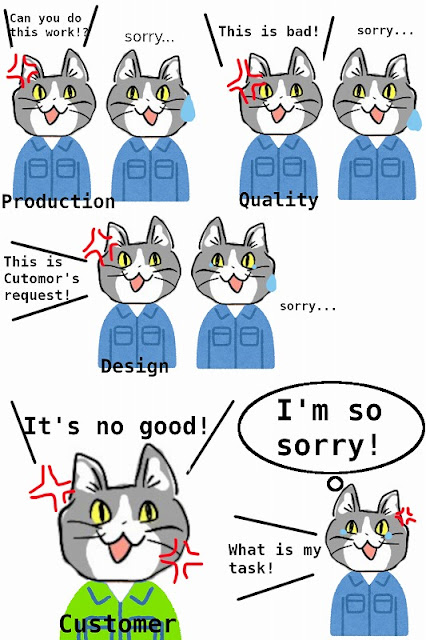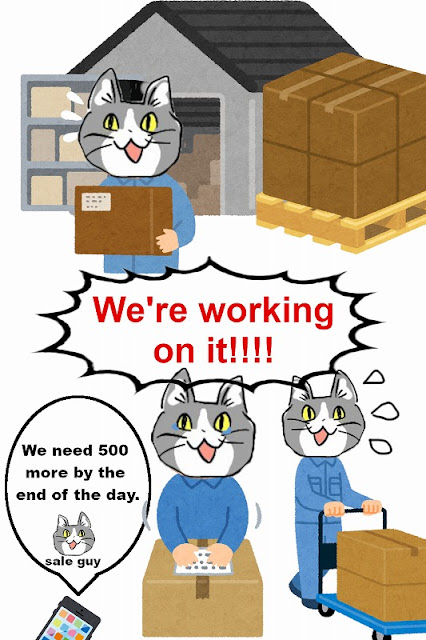What is packaging engineer?
Among the many types of engineers, packaging engineers are somewhat less well-known.
What does a packaging engineer, who is also called a packing or packaging manager depending on the company, do?
Here I introduce the hard work of packaging engineers, who may not be well known.
Packaging engineers are those who create packaging specifications.
A manufacturer, as the name implies, is a company that makes some product.
Whether BtoB or BtoC, products have packaging specifications, such as being in a box or on a pallet.
Packaging engineers are responsible for creating the packaging specifications.
For each part number, the work is endless: how many boxes to use, how many products to pack in each box, how to pack them in this way, and for the cushioning material, two sheets of paper folded like this, and plastic like that.
Then we negotiate with other departments on the completed packing specifications.
The quality department is asked if there is no problem with this packaging specification in terms of quality, the design department is asked if the packaging specification meets the customer's requirements, and the manufacturing department is asked if this packaging can be used on the production line.
When I was working for an automobile parts manufacturer, I also worked as a packaging engineer, and we used to call this coordination the "packing review meeting" and hold internal review meetings.
I can't remember a time when we didn't get into trouble at these packaging form review meetings.
In particular, I always bowed down to the manufacturing department and asked them to do something about it.
If the manufacturing department said it was too much trouble, we would redo it, if the quality department said it was no good, we would redo it, and so on.
Each time, we would come up with a compromise plan.
This is how we make packing specifications.
Packaging engineers are those who negotiate with customers.
The packing specification is also a type of work standard and is only for internal use.
In the case of BtoB business, it is necessary to obtain delivery permission from the client to whom the product is to be delivered.
We negotiate with the client with the packing specifications that we have created internally and the actual packed and finished packaging.
Duct time (the number of seconds it takes to make one product) is a lifeline for manufacturers, so clients do not easily say "Yes! ".
Car manufacturers such as Toyota and Honda are particularly strong opponents because they strictly check duct time throughout the company.
Each time, negotiations were so intense that internal negotiations seemed like heaven.
After all, the other party is the customer.
We are in the weak position of purchasing a product, and we have to get a stamp of approval from the customer who has a seal of approval.
Moreover, we cannot start mass production because we cannot deliver the product without approval.
When negotiations end in failure, the company is angry.
Perhaps because of this, there was a high turnover rate of packaging engineers at the company where I worked.
They are solitary negotiators.
Negotiation skills are honed, though....
Packaging engineers are those who obtain export licenses.
If goods are to be exported overseas, and if the goods are classified as dangerous goods of any kind, they must meet the UN advisory standards.
Dangerous goods include explosives and alcohol and are classified from Class 1 to Class 9.
All dangerous goods must undergo and pass a box test called the Marine Equipment Inspection Test, as well as an accompanying test, before receiving a certificate of approval.
For example, if seat belts or airbags are to be exported overseas in corrugated cardboard packaging, they must undergo the Marine Equipment Inspection Test for corrugated cardboard and also pass an external fire test, which is an ancillary test, before they can be exported.
Since the certification test for marine use is to examine the strength of corrugated fiberboard, the corrugated fiberboard manufacturer has some knowledge of the strength of the corrugated fiberboard and can tell in advance to some extent whether it is safe to use this level of strength, but the external fire test is more troublesome.
There is no way to know how it will explode until it is burned.
You can't tell without actually testing it, but the price for that test is 500,000 yen (the lowest price we could find) per test.
However, we could not export the product illegally, so we struggled every time.
Conclusion
Packaging engineers are not well known, but they are a must for manufacturers.
It is often a tough job, but the more difficult the job is, the more rewarding it is.
If you have a chance, challenging yourself will be a great opportunity for growth.
Thanks for reading!



コメント
コメントを投稿